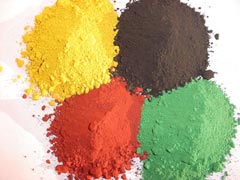Although nanometer transparent iron oxide is a kind of inorganic pigments in view of its synthetic and performance characteristics, it also owns properties of organic pigments. And transparent iron oxide belongs to nanometer crystals, because its particle size is
Nanometer Transparent Iron Oxide Pigment Series |
|||||||||||||||||
|
much smaller, only 0.01-0.015цm, compared with opaque one. The small size of nanometer crystals gives transparent iron oxide large specific surface area (about 128m2/g), which results in its high oil absorption, (up to 80-100), by comparison, phthalocyanine blue 56, phthalocyanine green 46, carbazole violet 84, opaque iron oxide 18. Since the particle diameter of transparent iron oxide is smaller than half light wavelength, it has transparent colors when scattered in the media and made into successive films. Moreover, due to its tiny particle diameter, nanometer transparent iron oxide is totally different from the opaque one in aspect of light absorption and scattering, thus it has vivid colors instead of dark colors performed by opaque iron oxide.Iron oxide nona particles, nona-structured iron oxide
Advantages of using Transparent Iron Oxide
- UV absorption : Transparent iron oxide pigments are effective absorbers of ultraviolet radiation, providing essential protection to resins and many substrates. The inclusion of these pigments, even at low levels, ensures significant protection against degradation resulting from UV exposure
- Stability: Both acid and alkali resistant, TRAFe™ pigments demonstrate outstanding weather fastness and gloss retention qualities. Yellow iron oxides exhibit thermal stability of approximately 160℃. Red grades, being a dehydrated form of yellow iron oxides, having undergone a calcination process at low temperatures, display higher thermal stability of around 300℃.
- Excellent transparency and weather fast colors for interior and exterior use: light fastness, weather fastness & durability.
- Excellent chemical stability: Can be used in combination with organic transparent pigments in both solvent and water borne systems
Application of Transparent Iron Oxide
-
Automotive Paints: used with aluminum pigments and pearl powder in the oil and water based systems to produce golden colors and used with organic transparent pigments to produce various transparent paints.
Transparent Iron Oxide Pigments - Wood protection: soft color, no fading, prevent ultraviolet radiation from damaging the wood.
- Powder coatings: coats on metal surface to produce gold or copper color, widely applicable for inner and outer coating of cans. for transparent iron oxide red, no change in color when the temperature is under 300℃
- Printing inks: vivid transparent colors suitable for the printing of aluminum foils.
- Decorative coatings: color can be kept for long periods of time
- Plastic packing: used in PET or PP plastic to make drinking cans and drug bottles.
- Cosmetics: widely applied in the cosmetics industry because it is toxin-free and has an excellent absorption capability to ultraviolet radiation.
2. Transpare Iron Oxide Dispersion Overview
“TRAFe” Transparent Iron Oxide Dispersions, with color of yellow, red,
Nanometer Transparent Iron Oxide Dispersion Series |
||||||||||||||||||||||||||||||||||||
|
||||||||||||||||||||||||||||||||||||
Application Instruction
If particles form when add transparent iron oxide dispersions into binder, the result is caused by the fast reaction between the dispersion and viscous binder. The method to avoid the problem is to take the following steps. Nona-structured Iron oxide pigments
- Take certain quantity of transparent iron oxide dispersion, and add solvent or water is into it to lower dispersion’s viscosity. The quantity of the solvent or water need to lower the pigment loading in the dispersion within 10%.
- Take right amount of bi nder, which is 5%-10% of the dispersion quantity, and add it into the above dispersion slowly while stirring in order to obtain low concentrated solution. Stir slowly and add the above obtained low viscous solution into the remaining binder.
Storage and Caution
The dispersions should be stored in well-sealed containers at a temperature under 35℃ and the storage period should not exceed 12months. The dispersions should be stirred evenly before being used and should be used up as soon as possible after unpacking. As for LSB type dispersion, when the storage temperature is above 35℃,volatility of solvent or the chemical reaction of the binder may cause formation of a skin on the surface of the dispersion and the skin should be removed before use.
